Eumorpha achemon
Eumorpha achemon
you-MOR-fuhmmACK-eh-mon
(Drury, 1773)
Sphinx
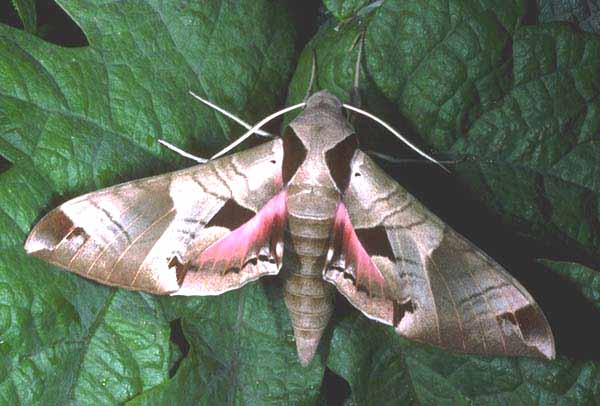
The Achemon Sphinx, Eumorpha achemon courtesy of T. W. Davies.
This site has been created by
Bill Oehlke at oehlkew@islandtelecom.com
Comments, suggestions and/or additional information are welcomed by Bill.
| TAXONOMY:
Superfamily: Sphingoidea, Dyar, 1902
Family: Sphingidae, Latreille, 1802
Subfamily: Macroglossinae, Harris, 1839
Tribe: Philampelini, Burmeister,
Genus: Eumorpha, Hubner, [1807]
Species: achemon, (Drury, 1773) |
MIDI MUSIC
"What.A.Wonderful.World"
copyright C. Odenkirk
MIDI CITY
ON.OFF
<bgsound src="world.mid" LOOP=FOREVER>
|
DISTRIBUTION:
The Achemon Sphinx, Eumorpha achemon (Wing span: 3 5/16 - 3 3/4 inches
(8.7 - 9.6 cm)), flies from Maine west to North Dakota (into Manitoba) and southern Oregon; south to south Florida, west to southern California
and Mexico wherever larval hosts can be found.
It has recently been confirmed in southern Saskatchewan.
Many thanks to Tina August who provides the following image of Eumorpha achemon from Brandon, Manitoba.
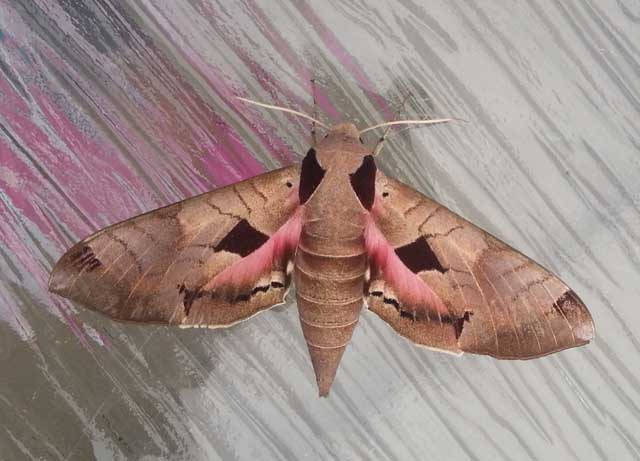
Eumorpha achemon, Brandon, Manitoba,
August 10, 2013, courtesy of Tina August.
Tina writes, "Hi there,
"I wanted to share these photos with you of my fearless daughter who loves moths. She found this one and nicknamed her McKayla the moth. I posted it online and a
friend sent me to your website. This picture was taken in Brandon, Manitoba, Canada.
"Could you please confirm what kind of moth this is? We have never see one like this.
"Kind regards,
"Tina August"
I reply,
"Hi Tina,
"Mckayla the moth is Eumorpha achemon, one of the Sphingidae. This species is not often seen in Manitoba, but can be quite common further to the south
in most of the United States.
"Thanks for thinking of me and sharing the images you sent.
"Bill Oehlke"
The forewing is light grey and brown with many lines, and there are dark patches near the middle of the inner margin, near the apex and near the anal angle.
The entire basal area of the hindwing is pink.
May thanks to James Simon who sends the following image of Eumorpha achemon.
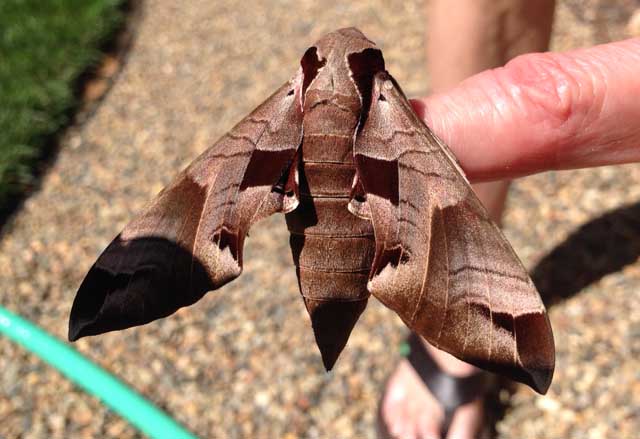
Eumorpha achemon, Sacramento, California,
May 15, 2014, courtesy of James Simon.
James writes, "These photos were taken just under a grape vine on the ground in the morning. It was very still and didn't mind our handling for a while. It
eventually flew back down to the ground and we left it alone.
"We noticed the pinkish color at the base of the wings but didn't get a photo of the color. Your site said that there were no Sacramento sightings so I thought if we
had this right it would be of interest."
Visit Eumorpha achemon, Glen Burnie, Anne Arundel County, Maryland, August 16, 2008, courtesy of Saundra Byrd.
Visit Eumorpha achemon, Shreveport, Caddo Parish, Louisiana, July 8, 2006, Jeff Trahan.
Visit Eumorpha achemon adult, Greenwood Village, Arapahoe County, Colorado, courtesy of Mary Anne Shube.
Visit Eumorpha achemon adult, Wolf Creek, Josephine County, Oregon, courtesy of
Edna Woodward, from reared larvae from eggs; also July 17, 2011, at lights.
Visit Eumorpha achemon, Hitaga Sand Ridge Prairie Reserve, Linn County, Iowa, July 8, 2010, Thomas Jantscher.
Edna Woodward of Wolf Creek, Josephine county, southwestern Oregon observes: "I would say they don't come to the lights all that well until I got the black light."
Some moth species definitely respond better to some wavelengths than they do to others. I often receive images of the Achemon Sphinx (Eumorpha achemon) larvae, but seldom receive images
of the adult moths at lights. On the other hand, I receive many digital images of Pandorus Sphinx (Eumorpha pandorus) adults responding to normal house lights.
Sargent observed similar differences in many Catocala species when comparing responses to either Mercury Vapour or black lights. He also observed that some Catocala species
respond much better to bait than they do to any type of light.
Visit Eumorpha achemon larva and adult, Willingboro, Burlington County, New Jersey,
July-August 2010, Colleen Magnuson.
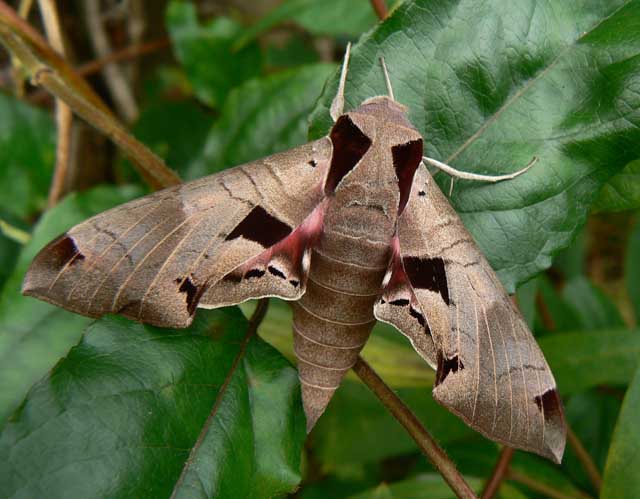
Eumorpha achemon, Rockport, Essex County, Massachusetts, courtesy of Kim Smith.
Those who first published descriptions and
assigned scientific names to many insects, simply chose names of
biblical or mythological origin without any real descriptive
qualities. Their purpose was simply to set a standard for purposes
of identification by assigned name. On some occasions, names,
mostly of Latin or Greek origin, were chosen to signify a particular
character of the genus or of an individual species.
The genus name "Eumorpha" means well-formed.
In Greek mythology, Achemon and his brother Basalas were two
Cercopes who were constantly arguing. One day they insulted Hercules,
who tied them by their feet to his club and marched off with them
like a brace of hares.
The pronunciation of scientific names is
troublesome for many. The "suggestion" at the top of the page is
merely a suggestion. It is based on commonly
accepted English pronunciation of Greek names and/or some
fairly well accepted "rules" for latinized scientific names.
The suggested pronunciations, on this page and on other pages,
are primarily put forward to assist those who hear with internal
ears as they read.
There are many collectors from different countries whose
intonations and accents would be different.
FLIGHT TIMES AND PREFERRED FOOD PLANTS:
Eumorpha achemon adults are on the wing from
June-August in the north as a single brood. There are two flights,
from May-August, in the south. The larva below, courtesy of David
Bygott, was found in April on a grape vine in Tucson, Arizona. The
adult moth eclosed in the same month. I suspect there are flights as
early as late February-early March in the more southerly states, with
the possibility of multiple broods.
Terrie Morin documents an adult Eumorpha achemon, from Lancaster, Los Angeles County, California, October 28, 2014.
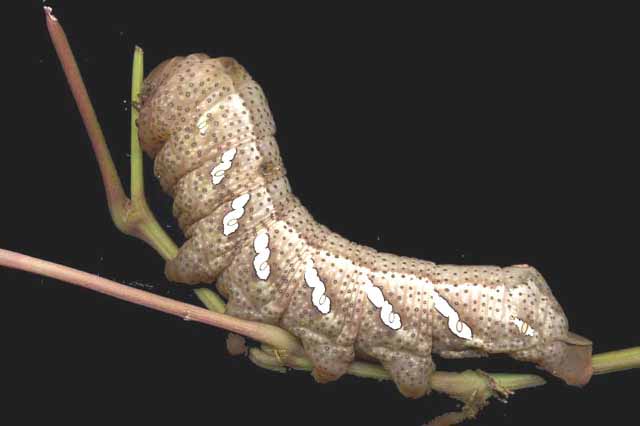
Adults nectar from
flowers of Japanese honeysuckle (Lonicera japonica), petunia (Petunia hybrida), mock orange
(Philadelphus coronarius), and phlox (Phlox).
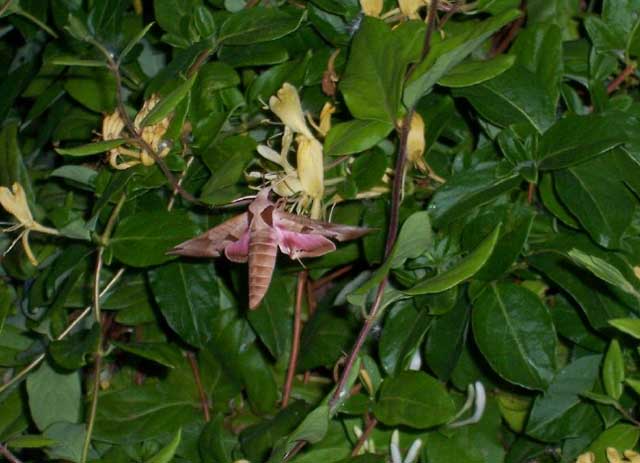
Eumorpha achemon May 29, 2008, nectaring at honeysuckle,
Inyo County, California, courtesy of Ruth Nielsen.
Eumorpha achemon larvae feed upon Grape (Vitis), Virginia Creeper (Parthenocissus quinquefolia)
and other vines and ivies (Ampelopsis).
Larvae get quite large and occur in both a light (green) form, a reddish-orange form, and a darker (tan/brown) form. The dark form, courtesy of
Chris Conlan is depicted below.
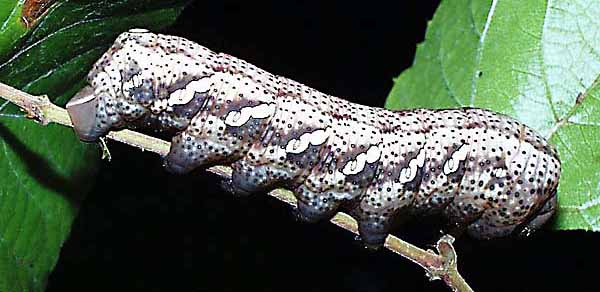
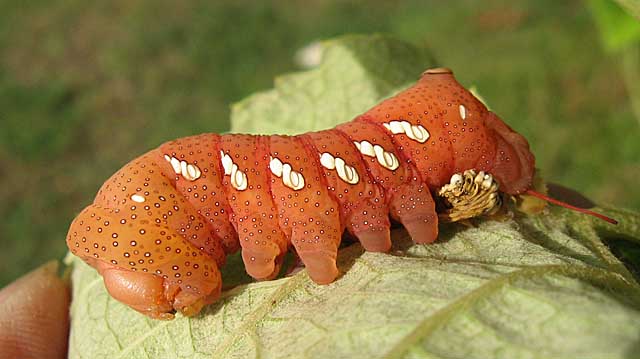
Eumorpha achemon, Slocomb, Geneva County, Alabama,
September 21, 2008, courtesy of Joan Brown.
The larva depicted above has just shed its skin, visible between its fourth and fifth set of prolegs. The red anal horn, so prevalent in
previous instars, is still affixed to the old skin and projects obliquely across the grape leaf stem. In place of the horn there is now
a slightly raised "eye".
ECLOSION, SCENTING AND MATING:
Pupae wiggle to surface just prior to eclosion. Females call at
night, and males fly into the wind to pick up and track the pheromone plume. Summer brood moths emerge about fifteen days after pupation (CM).
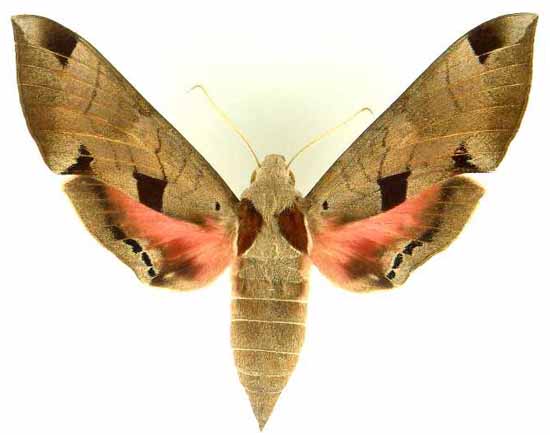
Eumorpha achemon female, Louisiana, courtesy of
Vernon A. Brou.
EGGS, LARVAE AND PUPAE:
Females oviposit on upper surfaces of older leaves during their ovipositing
flights at night.
Eggs hatch in six to nine days, depending upon
temperature and humidity.
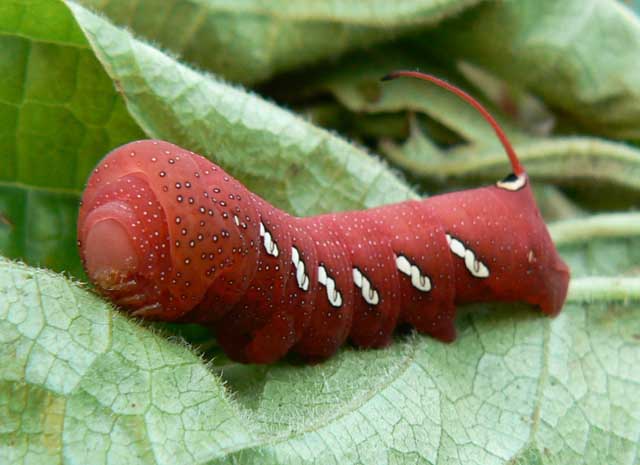
Eumorpha achemon, third or fourth instar (red-brown form), August 16,2008,
Rockport, Essex County, Massachusetts, courtesy of Kim Smith.
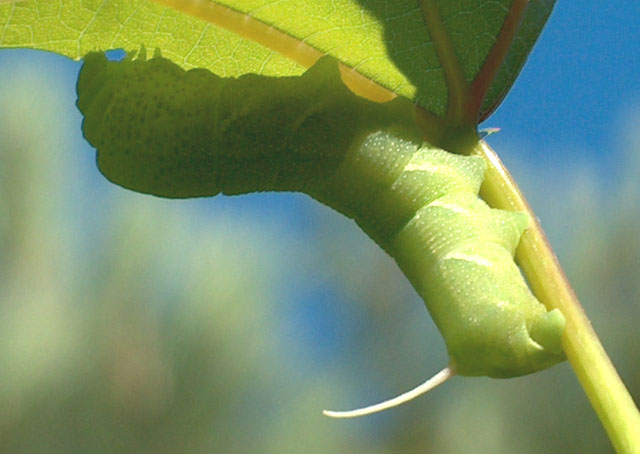
Eumorpha achemon, third or fourth instar larva (green form), June 25, 2005,
Lake Elsinore in Riverside County, courtesy of Peter Sidoruk.
When the Eumorpha achemon caterpillars first
hatch from almost globular dark green eggs
(yellow somewhat just before hatching), the anal horn is dark
and as long as the body, ending in two setae. At its base is a red brown
patch extending part way onto the anal shield.
Egg incubation can be as few as six days, and eggs
are deposited singly. The hatchling larvae have large pale green
heads and yellow green bodies, feet and legs.
Larvae can shed skins and move into an identical looking second instar,
except the heads are now in better proportion to the body
(i.e., don't
seem so large) and yellowish-white subdorsal lines and tiny dots are present.
In warm conditions larvae can molt again in as few as three or four
days. The six-eight irregular (almost segmented) oblique lines,
diagnostic of E. achemon, appear in the third instar.
The anal horn now angles away from the head instead of over the back.
Immature larvae have the characteristic horn-like tail which drops
off (i.e., does not develop) after the fourth instar. Feeding lasts for three to
four weeks and full grown larvae leave the host to pupate in undeground burrows. Image courtesy of Chris Conlan.
During the second generation, larvae frequently become quite numerous and do considerable damage to
grapevines. | 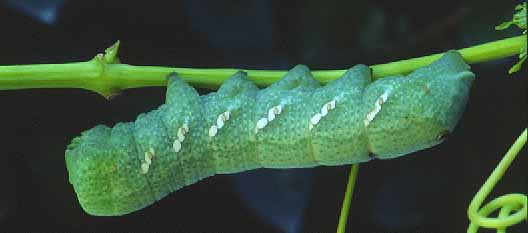 |
Visit beautiful images of a Eumorpha achemon
final instar larva, Texas panhandle, July 20, 2010, courtesy of Wallace B. and GayAnn Thompson.
Visit Eumorpha achemon fourth instar, Windham Centre, Norfolk County, Ontario, Canada, July 27, 2011, Lynda Amorim
Visit Eumorpha achemon, larva, Ozaukee County, Wisconsin, Kate Redmond
Larval Food Plants
Listed below are primary food plant(s) and alternate food plants. It is hoped that this
alphabetical listing followed by the common name of the foodplant will
prove useful. The list is not exhaustive. Experimenting with closely
related foodplants is worthwhile.
Parthenocissus quinquefolia.....
Vitis
Ampelopsis | Virginia creeper
Grape
Vines and Ivies
|
Return to U. S. A. Table
Return to Philampelini Index
Return to Sphingidae Index
Use your browser "Back" button to return to the previous page.
This page is brought to you by
Bill Oehlke and the
WLSS. Pages are on space rented from Bizland. If you would like
to become a "Patron of the Sphingidae Site", contact Bill.
Please send sightings/images to Bill. I will do my best to respond to
requests for identification help.
Enjoy one of nature's wonderments: Live
Saturniidae (Giant Silkmoth) cocoons.
 | 
Show appreciation for this site by clicking on flashing butterfly to the left.
The link will take you to a page with links to many insect sites. |













